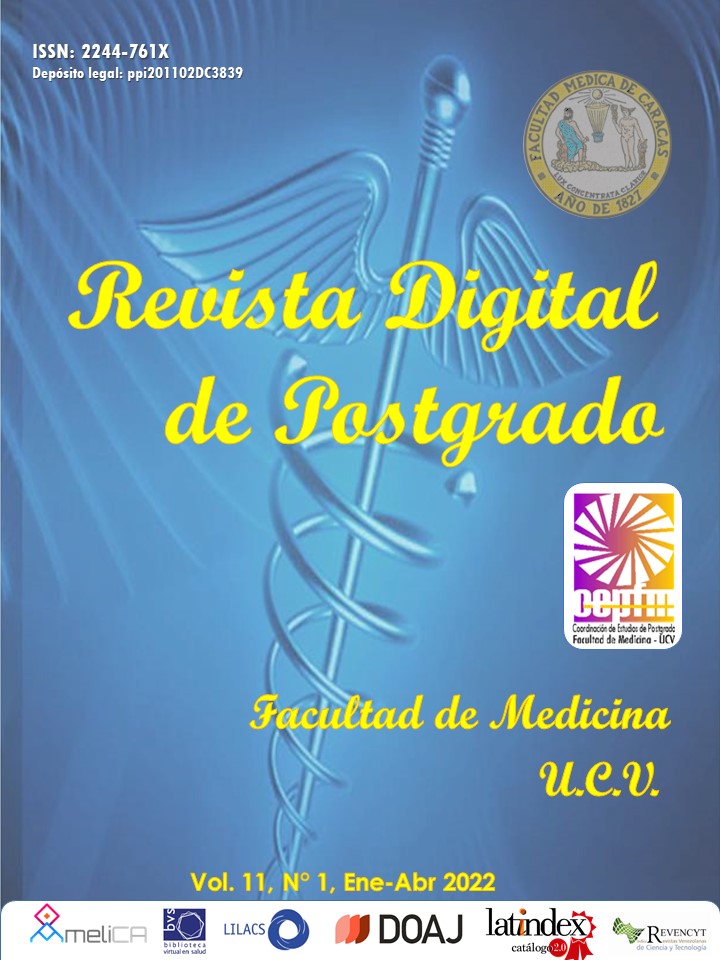Two formulas for calculating BMI, and their relationship to other anthropometric indicators in adults
Keywords:
BMI Quetelet, BMI Oxford, Overweight, Obesity, Body Fast, Sensitivity.Abstract
Descriptive, prospective, transversal and correlational study, whose objective is to relate two formulas for calculating BMI, with other indicators, in a group of adults. METHODS: The sample is of 137 adult patients who attended consultation at the University Hospital of Caracas. The variables are: age, weight, size, BMI-Q, BMI-O, WC, WSI, WCWP and BFP. Averages, deviations, percentages and z-tests and Mann Whitney were obtained to compare averages and Median. RESULTS: Similar BMI-Q averages in both sexes, and older BMI-O in female sex. The two formulas for calculating BMI result in the highest percentage with BMI-O, higher overweight percentage with BMI-Q and significant (p<0.000) and percentages of Healthy Weight and Obesity equal. Equal averages, per group, of BFP for the two BMI formulas, and increase from Healthy Weight to Obesity. The Coefficient of Variation reveals more homogeneity in BMI-O (18.41% vs 25.21%). BMI-Q correlates with weight (0.91), WC (0.92) and WSI (0.93); IMC-O with weight (0.97), WC (0.83) and WCWI (0.90). Whitney's test reveals that averages by sex are significant (p<0,000), as are IPCC averages per sex (p<0.000). In addition, the BMI Oxford, WC, WSI and WCWI indicators have sensitivity of 92,3%, 92.3% and 92.3%, respectively. CONCLUSION: The BMI Oxford for its somewhat complicated calculation formula is not recommended to evaluate overweight and obesity, in adults.Downloads
References
WHO. Technical Report Series 894. Obesity: Preventing and Managing the Global Epidemic. Geneva; 2000.
World Health Organization. Fact sheet: obesity and overweight. Available online: http://www.who.int/mediacentre/factsheets/fs311/en/ (accessed on 5 October 2009).
Rolland-Cachera MF, Akrout M, Péneau S. History And Meaning Of The Body Mass Index. Interest Of Other Anthropometric Measurements. In M.L. Frelut (Ed.), The ECOG’s eBook on Child and Adolescent Obesity. 2015; (Internet): (citado 2020 Ma 20). Disponible en: https://ebook.ecog-obesity.eu/wp-content/uploads/2015/02/ECOG-Obesity-eBook-History-and-Meaning-of-the-Body-Mass-Index.-Interest-of-Other-Anthropometric-Measurements-.pdf
Instituto Nacional de Nutrición (INN). Sobrepeso y obesidad en Venezuela (Prevalencia y factores condicionantes). Colección Lecciones Institucionales. Fondo Editorial Gente de Maíz; 2013.
Trefethen N. University of Oxford. The Economist published this letter from me. (Internet) (citado 2020 May 20). Disponible en: http:///New%20BMI%20(New%20Body%20Mass%20Index).html
Quetelet A. Physique sociale, ou essai sur le développement des facultés de l’homme. Volume 1. 1st ed. Bruxelles: Muquardt; 1869.
World Health Organization. Measuring Obesity: Classification and Distribution of Anthropometric. Copenhagen: World Health Organization; 1989.
Rodríguez-Rodríguez E, López-Plaza B, López-Sobaler AM, Ortega RM. Prevalencia de sobrepeso y obesidad en adultos españoles. Nutr Hosp 2011; 26 (2): 355-363
Bauce G. Three indicators for overweight and obesity: BMI, CC and P/CC-index in children and adolescents: Pilot study. MOJ Biology and Medicine. 2018; 3(3).
Bauce G, Moya-Sifontes M. Índice Peso Circunferencia de Cintura como indicador complementario de sobrepeso y obesidad en diferentes grupos de sujetos. Rev Digit Postgrado. 2020; 9(1): e195. Doi: 10.37910/RDP.2020.9.1.e195
Carbajal Á. Manual de Nutrición y Dietética. Departamento de Nutrición. Facultad de Farmacia. Universidad Complutense de Madrid. [Internet] 2013. [Citado 2019 Mar 07]. Disponible en: https://www.ucm.es/data/cont/docs/458-2013-07-24-cap-2-composicion-corporal55.pdf
Moreno M. Circunferencia de cintura: una medición importante y útil del riesgo cardiometabólico. Rev Chil Cardiol. 2010; 29: 85-87.
SEEDO. Revista Española de Obesidad. Consenso SEEDO 2007 para la Evaluación del sobrepeso y la obesidad y el establecimiento de criterios de intervención terapéutica (versión íntegra) (Internet) (citado 2020 May 20). Disponible en: http://www.Consenso_SEEDO_2007%20Obesidad.pdf
CDC. Anthropometric Reference Data for Children and Adults: United States, 2011–2014. Data from the National Health and Nutrition Examination Survey. U.S. Department of health and human services. (Internet) (citado 2020 May 26) Disponible en: https://www.cdc.gov/nchs/data/series/sr_11/sr11_252.pdf
Méndez-Pérez B, Martín-Rojo J, Castro V, Herrera-Cuenca M, Landaeta-Jiménez M, Ramírez G, et al. Estudio Venezolano de Nutrición y Salud: Perfil antropométrico y patrón de actividad física. Grupo del Estudio Latinoamericano de Nutrición y Salud. An Venez Nutr. 2017; 30(1).
How to Cite
Issue
Section
License
Usted es libre de:
- Compartir — copiar y redistribuir el material en cualquier medio o formato
- Adaptar — remezclar, transformar y construir a partir del material
- para cualquier propósito, incluso comercialmente.
Bajo los siguientes términos:
-
Atribución — Usted debe dar crédito de manera adecuada, brindar un enlace a la licencia, e indicar si se han realizado cambios. Puede hacerlo en cualquier forma razonable, pero no de forma tal que sugiera que usted o su uso tienen el apoyo de la licenciante.
- No hay restricciones adicionales — No puede aplicar términos legales ni medidas tecnológicas que restrinjan legalmente a otras a hacer cualquier uso permitido por la licencia.











